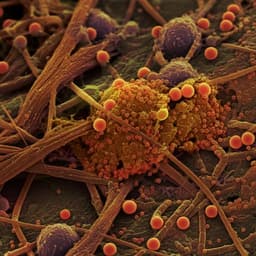
Earth Sciences
Microbial contribution to post-fire tundra ecosystem recovery over the 21st century
N. J. Bouskill, Z. Mekonnen, et al.
Tundra ecosystems are facing an increase in fire frequency. This research, conducted by Nicholas J. Bouskill and colleagues, reveals that the nitrogen cycle accelerates post-fire recovery due to complex microbial interactions, significantly enhancing plant productivity through nutrient release. Discover the implications of these findings for ecosystem models and nutrient cycling.
~3 min • Beginner • English
Introduction
Arctic permafrost soils store vast organic carbon stocks (~1000 PgC in top 3 m) that may contribute to atmospheric greenhouse gases as the Arctic warms at twice the global average. Warming, drought, and increased lightning have elevated tundra fire frequency and severity, imposing strong disturbances on surface energy balance, soil hydrology, carbon stocks, nutrients, and biotic communities. Recovery dynamics, especially the coupled plant–microbe processes and their implications for carbon cycling under continued climate change, remain uncertain. This study applies the mechanistic ecosys model, benchmarked to observations from the severe 2007 Anaktuvuk River Fire (ANF) in Alaska, to investigate: (1) long-term ramifications of fire under 21st-century climate change (RCP8.5); (2) the role of belowground microbial communities in enabling plant community recovery; and (3) differences in recovery between an early-century graminoid-dominated state and a late-century shrub-dominated state.
Literature Review
Prior work has shown tundra fires alter energy balance, soil hydrology, reduce carbon stocks, increase nutrient losses, and shift plant and microbial communities. Vascular plants (graminoids and shrubs) tend to recover faster than cryptogams (mosses, lichens). Graminoids recover rapidly; shrubs can take a decade or more yet may expand beyond pre-fire states under warming. Microbial communities are directly impacted by heat and indirectly by altered nutrient and carbon availability; bacteria often recover faster than fungi, though mycorrhizal fungi may be buffered by resprouting shrubs. Warming-driven shrub expansion increases litter C:N, favoring fungi and potentially slowing decomposition relative to bacteria. These vegetation–microbe shifts feed back on carbon and nutrient cycles. Models have predicted continued Arctic carbon sinks driven by increased NPP, shrub expansion, deeper active layers, and enhanced nutrient release from thawing permafrost, but the interaction with acute fire disturbances and explicit microbial functional dynamics has been less represented.
Methodology
Study site and data: The ecosys model was parameterized for the Anaktuvuk River Fire (ANF) site on Alaska’s North Slope (68.5838°N, 149.7178°W), underlain by continuous permafrost. Site climate and edaphic properties were initialized from published sources and databases (e.g., NARR meteorology, Unified North America Soil Map, Northern Circumpolar Soil Carbon Database). Observations used for benchmarking included plant community metrics, soil carbon stocks, and physical factors collected before and after the 2007 ANF. Model benchmarking used RMSE and comparisons to observed NPP by plant functional type (PFT), soil carbon profiles, and active layer depth (ALD).
Model description: Ecosys is a multilayer, hourly time-step land ecosystem model with coupled energy, water, carbon, nitrogen (N), and phosphorus (P) cycles, simulating soil heat and water fluxes, freezing/thaw, and plant hydraulics. Microbial community structure is represented by eleven functional groups, including aerobic heterotrophic bacteria, saprotrophic fungi, denitrifiers (facultative), nitrifiers (ammonia and nitrite oxidizers), diazotrophic bacteria (aerobic and anaerobic), methanogens, and methanotrophs. Microbial growth, maintenance, and mortality depend on substrate availability, stoichiometry (C:N:P), redox energetics (ΔG), temperature (modified Arrhenius), and soil water content. Organic matter (OM) is partitioned into active pools (protein, carbohydrate, cellulose, lignin) and passive mineral-associated pools with sorption (Freundlich isotherm). Plant–microbe competition for inorganic (NH4+, NO3−, H2PO4−) and organic nutrients is explicitly represented.
Plant Functional Types: Four PFTs were parameterized from ANF observations: graminoids (Eriophorum-like), evergreen shrubs (Ledum palustre), deciduous shrubs (Betula nana), and nitrogen-fixing mosses (Hylocomium splendens). PFT-specific traits include canopy structure, nutrient contents and remobilization, turnover, root hydraulics, and mycorrhizal associations. Evergreen shrubs are conservative (slower growth, higher nutrient remobilization), while deciduous shrubs invest more in nutrient uptake and have higher potential CO2 fixation under nutrient-rich conditions.
Simulation protocol: Spin-up from 1900–2000 used historical climate, CO2, and N deposition. Transient simulations from 2000–2100 used downscaled RCP8.5 forcings (15-member CMIP5 ensemble averages) including air temperature, precipitation, radiation, relative humidity, wind, atmospheric CO2, and reactive N deposition. Fire perturbations were prescribed with severities informed by published syntheses: mild (5 cm burn depth; 25% OM combustion), moderate (11 cm; 50%), and severe (16 cm; 85%). Fire timing scenarios: early century (2007) when graminoids dominate vs late century (2080) when shrubs dominate. Each fire scenario was run atop the RCP8.5 trajectory; a baseline RCP8.5-no_fire scenario was also simulated.
Analyses: Model performance was assessed by RMSE versus observations. Post-fire and climate impacts were analyzed for NPP (total and PFT), soil C (0–1 m), ALD, soil moisture and temperature profiles, greenhouse gas fluxes (CO2, CH4, N2O), microbial biomass by functional group and depth, and soil inorganic N and P dynamics. An information theory approach (transfer entropy) quantified directional influences of environmental and biogeochemical drivers (e.g., nutrients, soil moisture/temperature, ALD, snowpack, microbial biomass) on NPP. Statistical tests included ANOVA for differences among scenarios.
Reproducibility: Model code (ECOSYS) is available on GitHub, and simulations and analysis scripts are archived at ESS-DIVE with a DOI.
Key Findings
Model benchmarking: Simulated values agreed well with observations (normalized RMSE = 0.037). Prefire total NPP ~200±40 gC m−2 yr−1 and 4 years post-fire ~160±10 gC m−2 yr−1 were reproduced. By PFT, graminoid NPP prefire was ~120±40 gC m−2 yr−1 (obs ~125), evergreen shrub ~75±20 gC m−2 yr−1 (obs 75). Simulated prefire soil C (0–20 cm) was 6320±355 gC m−2 (obs 7682±766 gC m−2), total 0–1 m soil C was 42.3 kgC m−2. ALD pre/post-fire matched observations.
Baseline (RCP8.5, no fire): NPP more than doubled from ~200 to ~530 gC m−2 yr−1 by 2100; despite increased respiration, the ecosystem remained a carbon sink and soil C increased by 0.67 kgC m−2 (~1.5%) by 2100. ALD deepened to ~50 cm by 2060 and ~90 cm by 2100. Annual mean surface soil temperatures rose from ~−2 °C to ~+3 °C; soil moisture increased in upper and deeper layers with ALD changes. Microbial biomass increased, especially fungi in surface soils, raising the fungal:bacterial biomass ratio with shrub expansion. Transfer entropy identified nutrient cycling (availability and plant assimilation), snowpack, soil moisture, and temperature as key drivers of increasing NPP.
Fire impacts on carbon: Combustion losses scaled with severity: mild ~550 gC m−2, moderate ~1400 gC m−2, severe ~2400 gC m−2, consistent with observed ANF carbon loss (2016 gC m−2). Post-fire soil C recovery differed by timing and severity: a mild fire in 2080 recovered to prefire soil C within ~8 years and then exceeded it; other scenarios did not reach prefire soil C within 20 years. Late-century moderate/severe fires reached new quasi-steady states faster than early-century fires.
Vegetation recovery: NPP reductions were larger for late-century fires. After early-century fires, graminoids dominated immediate post-fire productivity; shrubs recovered more slowly but expanded earlier than in the no-fire baseline, with faster expansion after severe fires. By century’s end, shrubs (especially deciduous) dominated community NPP. Mosses were decimated and required ~30 years to re-establish meaningful NPP. Transfer entropy highlighted soil moisture, temperature, and nutrient availability/uptake as critical to NPP recovery; late-century recovery depended more on deeper (>0.5 m) soil conditions.
Soil physics: Early-century fires caused ALD to deepen by up to 0.2 m within 8 years; soil moisture and temperature remained elevated for years post-fire. Late-century fires also deepened ALD, with severe scenarios showing ~0.2 m deeper ALD by 2100; soil moisture and temperature exhibited long-lasting fluctuations relative to baseline.
Microbial succession and nutrients: Fire reduced saprotrophic fungi by ~30% at 5–20 cm depth, creating niche space for fast-growing heterotrophic bacteria in the first 5 years, especially in warm, nutrient-rich shallow soils where bacteria remained dominant over the century. At ~10 cm depth, fungi outcompeted bacteria by ~10 years post-fire. Community C:N declined from ~8.5 to ~6.6, indicating bacterial dominance. Enhanced SOM mineralization by bacteria released NH4+ and PO4, fueling plant recovery and stimulating nitrification and denitrification. Diazotrophs increased in abundance and spatial extent across severities and timings; nitrogen fixation recovered quickly and exceeded baseline for late-century severe fires but remained insufficient to offset large N deficits. Nitrification remained elevated for decades in non-adapted systems; NO3− was rapidly lost hydrologically or taken up. N2O emissions increased, with the largest emissions (1.3×10−2 gN m−2) under a late-century mild fire due to wetter soils and denitrification niches.
Early vs late-century responses: Early-century severe fires led to incomplete recovery of NPP and soil C by 2100 and sustained N deficits and inorganic N losses. Late-century fires occurred in nutrient-richer, shrub-influenced systems with deeper ALD and warmer soils; nutrient availability and winter microbial activity accelerated recovery, and mild late-century fires achieved soil C recovery within two decades.
Discussion
The model indicates that under continued warming (RCP8.5) without fire, the site remains a carbon sink, driven by non-linear NPP increases associated with graminoid productivity and shrub expansion. Warming, deeper ALD, and increased soil moisture and winter microbial activity enhance OM decomposition and nutrient release, enabling plant growth and facilitating shrubification consistent with observations.
Fire superimposed on warming triggers rapid graminoid recovery due to transiently elevated N and P availability, while shrubs re-establish more slowly but ultimately dominate, especially after severe early-century fires. Transfer entropy analyses emphasize that nutrient availability and uptake, modulated by soil moisture, temperature, snowpack, and ALD, control NPP recovery. Post-fire nutrient cycles initially become open, with peak hydrological and gaseous N losses and reduced plant competition, enabling fast-growing bacteria to dominate decomposition. Bacterial mineralization accelerates nutrient release, aiding plant recovery, while diazotrophs expand but contribute relatively little to balancing N budgets. Nitrification remains elevated for decades until plant–microbe competition closes N cycles.
Early-century severe fires cause long-lived deficits in soil C and N that are not fully replenished by 2100, reflecting slow belowground recovery and continued N leakage. In contrast, late-century fires occur in systems with higher nutrient availability and deeper rooting access; equilibrium between microbial immobilization and plant uptake is reached more quickly, resulting in faster NPP and soil C recovery (particularly under mild severity). Overall, explicit microbial functional dynamics critically shape post-fire ecosystem trajectories and carbon–nutrient feedbacks under climate change.
Conclusion
Microbial functional dynamics underpin tundra ecosystem recovery from wildfire under 21st-century warming. Fires initially shift communities toward fast-growing bacterial heterotrophs that accelerate SOM mineralization and nutrient release, facilitating plant recovery, followed by a gradual return of fungal dominance at depth. Recovery trajectories depend on fire timing and severity and the nutrient and thermal state of the system: early-century severe fires yield persistent N and C deficits, whereas late-century, nutrient-richer conditions promote more rapid recovery, with shrubs increasingly dominating vegetation. Incorporating explicit microbial processes and plant–microbe interactions into terrestrial ecosystem models is essential to reduce uncertainties in tundra carbon–climate feedbacks. Future research should extend multi-site, multi-disturbance evaluations, refine microbial trait parameterization and depth-resolved processes, and assess impacts of changing fire return intervals on long-term soil C stability and nutrient cycling.
Limitations
Findings are based on simulations from a single, well-studied site (Anaktuvuk River) and one climate trajectory (RCP8.5), which may limit generalizability across the heterogeneous Arctic. Fire severity was prescribed using literature-derived burn depths and OM combustion fractions rather than fully prognostic fire behavior. While model benchmarks to observed NPP, soil C, and ALD were strong, belowground microbial succession and nitrogen cycling responses remain challenging to validate empirically, and some microbial trait parameterizations introduce uncertainty. Projected responses depend on climate forcing, snowpack evolution, and hydrology; uncertainties in these drivers and in transfer entropy inference could affect attribution of controls on NPP recovery.
Related Publications
Explore these studies to deepen your understanding of the subject.







